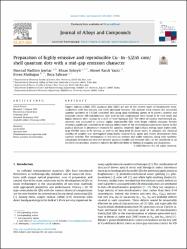Preparation of highly emissive and reproducible Cu-In-S/ZnS core/shell quantum dots with a mid-gap emission character
Özet
Copper indium sulfide (CIS) quantum dots (QDs) are one of the newest types of luminescent semiconductors with low-toxicity and earth-abundant features. The present work reports the successful aqueous synthesis of CIS/ZnS core/shell QDs using dual-stabilizing agents of N-acetyl-L-cysteine and trisodium citrate. Off-stoichiometric QDs with In-rich compositions were found to be very small and highly emissive after coating by a shell of wide bandgap ZnS. The effect of various experimental parameters was evaluated to achieve highly reproducible QDs with bright reddish emission. Results showed a significant contribution of mid-gap defect states in the recombination processes (based on the gradual increase in absorbance recorded for samples, relatively high Urbach energy, large Stokes shift, large FWHM value in PL spectra, as well as the long-lived PL decay time). In addition, the chemical stability of samples was investigated using highly oxidant H2O2 agent and results demonstrate their superior stability. The combination of low-toxicity, intense and stable emission, along with synthetic advantages demonstrates that the present aqueous-soluble and emissive QDs can be considered as an excellent bio-photonic structure suitable for different fields of biological imaging and diagnostics. (C) 2020 Elsevier B.V. All rights reserved.


















